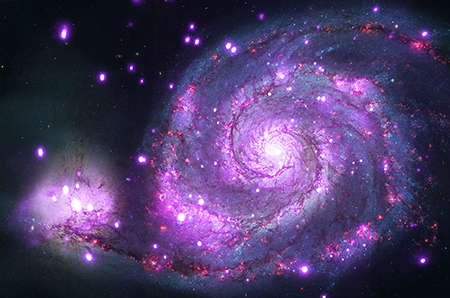The Whirlpool Galaxy Like You’ve Never Seen It Before
NASA's Universe of Learning, or UoL, provides resources and experiences that enable youth, families, and lifelong learners to explore fundamental questions in science, experience how science is done, and discover the Universe for themselves.
To make this goal a reality, this consortium of professional scientists, educators, visualizers, and more work together to create resources for anyone interested in learning about our Universe. The latest product from the UoL is a new visualization of Messier 51, also known as the Whirlpool galaxy. Located about 30 million light years from Earth, the Whirlpool galaxy is a spiral like our own Milky Way.
The Whirlpool Galaxy, M51
Credit: X-ray: NASA/CXC/Wesleyan Univ./R.Kilgard, et al; Optical: NASA/STScI
Watch as the graceful, winding arms of the Whirlpool are revealed in visible, infrared, and X-ray light (courtesy of the Hubble and Spitzer space telescopes, and the Chandra X-ray Observatory). Each wavelength region illustrates a different component of the stars, gas, and dust that comprise the galaxy, allowing astronomers to gain a broader and richer look into its detailed structure.
Visualization Credit: Frank Summers, Joseph DePasquale, Dani Player (STScI),
Kim Arcand (SAO/CXC), Robert Hurt (Caltech/IPAC)
Using its direct connection to the science and the experts behind the science, UoL creates and delivers timely and authentic resources and experiences for youth, families, and lifelong learners. The goal is to strengthen science learning and literacy, and to enable inquisitive learners to discover the Universe in innovative, interactive ways that meet today's 21st century needs.
The program is developed through a unique partnership between the Space Telescope Science Institute, Caltech/IPAC, the Jet Propulsion Laboratory, the Smithsonian Astrophysical Observatory, and Sonoma State University.

